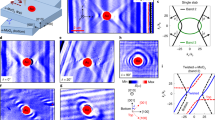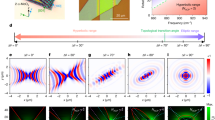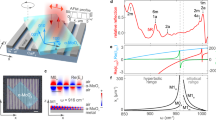Abstract
The emergence of a topological transition of the polaritonic dispersion in twisted bilayers of anisotropic van der Waals materials at a given twist angle—the photonic magic angle—results in the diffractionless propagation of polaritons with deep-subwavelength resolution. This type of propagation, generally referred to as canalization, holds promise for the control of light at the nanoscale. However, the existence of a single photonic magic angle hinders such control since the canalization direction in twisted bilayers is unique and fixed for each incident frequency. Here we overcome this limitation by demonstrating multiple spectrally robust photonic magic angles in reconfigurable twisted α-phase molybdenum trioxide (α-MoO3) trilayers. We show that canalization of polaritons can be programmed at will along any desired in-plane direction in a single device with broad spectral ranges. These findings open the door for nanophotonics applications where on-demand control is crucial, such as thermal management, nanoimaging or entanglement of quantum emitters.
This is a preview of subscription content, access via your institution
Access options
Access Nature and 54 other Nature Portfolio journals
Get Nature+, our best-value online-access subscription
$29.99 / 30 days
cancel any time
Subscribe to this journal
Receive 12 print issues and online access
$259.00 per year
only $21.58 per issue
Buy this article
- Purchase on Springer Link
- Instant access to full article PDF
Prices may be subject to local taxes which are calculated during checkout




Similar content being viewed by others
Data availability
The data that support the findings of this study are available from the corresponding authors upon reasonable request.
References
Cao, Y. et al. Unconventional superconductivity in magic-angle graphene superlattices. Nature 556, 43–50 (2018).
Park, J. M., Cao, Y., Watanabe, K., Taniguchi, T. & Jarillo-Herrero, P. Tunable strongly coupled superconductivity in magic-angle twisted trilayer graphene. Nature 590, 249–255 (2021).
Hunt, B. et al. Massive Dirac fermions and Hofstadter butterfly in a van der Waals heterostructure. Science 340, 1427–1430 (2013).
Dean, C. R. et al. Hofstadter’s butterfly and the fractal quantum Hall effect in moiré superlattices. Nature 497, 598–602 (2013).
Ponomarenko, L. et al. Cloning of Dirac fermions in graphene superlattices. Nature 497, 594–597 (2013).
Sharpe, A. L. et al. Emergent ferromagnetism near three-quarters filling in twisted bilayer graphene. Science 365, 605–608 (2019).
Jin, C. et al. Observation of moiré excitons in WSe2/WS2 heterostructure superlattices. Nature 567, 76–80 (2019).
Seyler, K. L. et al. Signatures of moiré-trapped valley excitons in MoSe2/WSe2 heterobilayers. Nature 567, 66–70 (2019).
Tran, K. et al. Evidence for moiré excitons in van der Waals heterostructures. Nature 567, 71–75 (2019).
Alexeev, E. M. et al. Resonantly hybridized excitons in moiré superlattices in van der Waals heterostructures. Nature 567, 81–86 (2019).
Hesp, N. C. et al. Observation of interband collective excitations in twisted bilayer graphene. Nat. Phys. 17, 1162–1168 (2021).
Sunku, S. S. et al. Hyperbolic enhancement of photocurrent patterns in minimally twisted bilayer graphene. Nat. Commun. 12, 1641 (2021).
Hesp, N. C. et al. Nano-imaging photoresponse in a moiré unit cell of minimally twisted bilayer graphene. Nat. Commun. 12, 1640 (2021).
Sunku, S. et al. Photonic crystals for nano-light in moiré graphene superlattices. Science 362, 1153–1156 (2018).
Hu, G., Krasnok, A., Mazor, Y., Qiu, C.-W. & Alù, A. Moiré hyperbolic metasurfaces. Nano Lett. 20, 3217–3224 (2020).
Hu, G. et al. Topological polaritons and photonic magic angles in twisted α-MoO3 bilayers. Nature 582, 209–213 (2020).
Chen, M. et al. Configurable phonon polaritons in twisted α-MoO3. Nat. Mater. 19, 1307–1311 (2020).
Duan, J. et al. Twisted nano-optics: manipulating light at the nanoscale with twisted phonon polaritonic slabs. Nano Lett. 20, 5323–5329 (2020).
Zheng, Z. et al. Phonon polaritons in twisted double-layers of hyperbolic van der Waals crystals. Nano Lett. 20, 5301–5308 (2020).
Herzig Sheinfux, H. & Koppens, F. H. The rise of twist-optics. Nano Lett. 20, 6935–6936 (2020).
Basov, D., Fogler, M. & García de Abajo, F. Polaritons in van der Waals materials. Science 354, aag1992 (2016).
Low, T. et al. Polaritons in layered two-dimensional materials. Nat. Mater. 16, 182–194 (2017).
Caldwell, J. D. et al. Low-loss, infrared and terahertz nanophotonics using surface phonon polaritons. Nanophotonics 4, 44–68 (2015).
Li, P. et al. Collective near-field coupling and nonlocal phenomena in infrared-phononic metasurfaces for nano-light canalization. Nat. Commun. 11, 3663 (2020).
Gomez-Diaz, J. S., Tymchenko, M. & Alu, A. Hyperbolic plasmons and topological transitions over uniaxial metasurfaces. Phys. Rev. Lett. 114, 233901 (2015).
Krishnamoorthy, H. N., Jacob, Z., Narimanov, E., Kretzschmar, I. & Menon, V. M. Topological transitions in metamaterials. Science 336, 205–209 (2012).
Zhang, Q. et al. Interface nano-optics with van der Waals polaritons. Nature 597, 187–195 (2021).
Tomarken, S. L. et al. Electronic compressibility of magic-angle graphene superlattices. Phys. Rev. Lett. 123, 046601 (2019).
Andrei, E. Y. & MacDonald, A. H. Graphene bilayers with a twist. Nat. Mater. 19, 1265–1275 (2020).
Yankowitz, M. et al. Tuning superconductivity in twisted bilayer graphene. Science 363, 1059–1064 (2019).
Rubio-Verdú, C. et al. Moiré nematic phase in twisted double bilayer graphene. Nat. Phys. 18, 196–202 (2022).
Shen, C. et al. Correlated states in twisted double bilayer graphene. Nat. Phys. 16, 520–525 (2020).
Ma, W. et al. In-plane anisotropic and ultra-low-loss polaritons in a natural van der Waals crystal. Nature 562, 557–562 (2018).
Zheng, Z. et al. A mid-infrared biaxial hyperbolic van der Waals crystal. Sci. Adv. 5, eaav8690 (2019).
Álvarez‐Pérez, G. et al. Infrared permittivity of the biaxial van der waals semiconductor α‐MoO3 from near‐and far‐field correlative studies. Adv. Mater. 32, 1908176 (2020).
Alonso-González, P. et al. Controlling graphene plasmons with resonant metal antennas and spatial conductivity patterns. Science 344, 1369–1373 (2014).
Pons-Valencia, P. et al. Launching of hyperbolic phonon-polaritons in h-BN slabs by resonant metal plasmonic antennas. Nat. Commun. 10, 3242 (2019).
Passler, N. C. et al. Hyperbolic shear polaritons in low-symmetry crystals. Nature 602, 595–600 (2022).
Hu, G. et al. Real-space nanoimaging of hyperbolic shear polaritons in a monoclinic crystal. Nat. Nanotechnol. 18, 64–70 (2023).
Taboada-Gutiérrez, J. et al. Broad spectral tuning of ultra-low-loss polaritons in a van der Waals crystal by intercalation. Nat. Mater. 19, 964–968 (2020).
Wang, C. et al. Van der Waals thin films of WTe2 for natural hyperbolic plasmonic surfaces. Nat. Commun. 11, 1158 (2020).
Álvarez-Pérez, G. et al. Active tuning of highly anisotropic phonon polaritons in van der Waals crystal slabs by gated graphene. ACS Photonics 9, 383–390 (2022).
Bapat, A. et al. Gate tunable light–matter interaction in natural biaxial hyperbolic van der Waals heterostructures. Nanophotonics 11, 2329–2340 (2022).
Ruta, F. L. et al. Surface plasmons induce topological transition in graphene/α-MoO3 heterostructures. Nat. Commun. 13, 3719 (2022).
Zeng, Y. et al. Tailoring topological transition of anisotropic polaritons by interface engineering in biaxial crystals. Nano Lett. 22, 4260–4268 (2022).
Hu, H. et al. Doping-driven topological polaritons in graphene/α-MoO3 heterostructures. Nat. Nanotechnol. 17, 940–946 (2022).
Ma, W. et al. Deep learning for the design of photonic structures. Nat. Photon. 15, 77–90 (2021).
Kudyshev, Z. A. et al. Machine learning–assisted global optimization of photonic devices. Nanophotonics 10, 371–383 (2021).
He, M. et al. Deterministic inverse design of Tamm plasmon thermal emitters with multi-resonant control. Nat. Mater. 20, 1663–1669 (2021).
Wiecha, P. R. et al. Deep learning in nano-photonics: inverse design and beyond. Photon. Res. 9, B182–B200 (2021).
Castellanos-Gomez, A. et al. Deterministic transfer of two-dimensional materials by all-dry viscoelastic stamping. 2D Mater. 1, 011002 (2014).
Frisenda, R. et al. Recent progress in the assembly of nanodevices and van der Waals heterostructures by deterministic placement of 2D materials. Chem. Soc. Rev. 47, 53–68 (2018).
Aguilar-Merino, P. et al. Extracting the infrared permittivity of SiO2 substrates locally by near-field imaging of phonon polaritons in a van der Waals crystal. Nanomaterials 11, 120 (2021).
Passler, N. C. & Paarmann, A. Generalized 4 × 4 matrix formalism for light propagation in anisotropic stratified media: study of surface phonon polaritons in polar dielectric heterostructures. J. Opt. Soc. Am. B 34, 2128–2139 (2017).
Acknowledgements
A.I.F.T.-M. and G.Á.-P. acknowledge support from the Severo Ochoa program of the Government of the Principality of Asturias (nos. PA-21-PF-BP20-117 and PA-20-PF-BP19-053, respectively). J.M.-S. acknowledges financial support from the Ramón y Cajal Program of the Government of Spain and FSE (RYC2018-026196-I) and the Spanish Ministry of Science and Innovation (State Plan for Scientific and Technical Research and Innovation grant no. PID2019-110308GA-I00). P.A.-G. acknowledges support from the European Research Council under starting grant no. 715496, 2DNANOPTICA and the Spanish Ministry of Science and Innovation (State Plan for Scientific and Technical Research and Innovation grant no. PID2019-111156GB-I00). A.Y.N. acknowledges the Spanish Ministry of Science and Innovation (grant PID2020-115221GB-C42) and the Basque Department of Education (grant PIBA-2020-1-0014). This project has also been supported by Asturias FICYT under grant AYUD/2021/51185 with the support of FEDER funds. These results also received support from a fellowship from ‘la Caixa’ Foundation (ID 100010434). The fellowship code is LCF/BQ/DI21/11860026. In addition, this work was supported by a 2022 Leonardo Grant for Researchers in Physics, BBVA Foundation. The foundation takes no responsibility for the opinions, statements and contents of this project, which are entirely the responsibility of its authors.
Author information
Authors and Affiliations
Contributions
J.D. and P.A.-G. conceived the study. P.A.-G. and A.Y.N. supervised the project. J.D. and A.I.F.T-M. fabricated the twisted samples. J.D. carried out the near-field imaging experiments. C.L., K.V. and G.Á.-P. carried out the numerical simulations and analytical calculations with the help of N.C.-R. and A.T.M.-L. J.D., P.A.-G., A.Y.N., J.M.-S., V.S.V. and G.Á.-P. participated in the data analysis. J.D., P.A.-G., G.Á.-P. and C.L. co-wrote the manuscript with input from the rest of the authors.
Corresponding authors
Ethics declarations
Competing interests
The authors declare no competing interests.
Peer review
Peer review information
Nature Materials thanks Andrey Bogdanov, Qiong Ma and the other, anonymous, reviewer(s) for their contribution to the peer review of this work.
Additional information
Publisher’s note Springer Nature remains neutral with regard to jurisdictional claims in published maps and institutional affiliations.
Supplementary information
Supplementary Information
Supplementary Figs. 1–17 and Sections 1–6.
Rights and permissions
Springer Nature or its licensor (e.g. a society or other partner) holds exclusive rights to this article under a publishing agreement with the author(s) or other rightsholder(s); author self-archiving of the accepted manuscript version of this article is solely governed by the terms of such publishing agreement and applicable law.
About this article
Cite this article
Duan, J., Álvarez-Pérez, G., Lanza, C. et al. Multiple and spectrally robust photonic magic angles in reconfigurable α-MoO3 trilayers. Nat. Mater. 22, 867–872 (2023). https://doi.org/10.1038/s41563-023-01582-5
Received:
Accepted:
Published:
Issue Date:
DOI: https://doi.org/10.1038/s41563-023-01582-5
This article is cited by
-
Van der Waals quaternary oxides for tunable low-loss anisotropic polaritonics
Nature Nanotechnology (2024)
-
Observation of naturally canalized phonon polaritons in LiV2O5 thin layers
Nature Communications (2024)
-
Tunable anisotropic van der Waals films of 2M-WS2 for plasmon canalization
Nature Communications (2024)
-
A twist for nanolight
Nature Materials (2023)
-
Extreme light confinement and control in low-symmetry phonon-polaritonic crystals
Nature Reviews Materials (2023)



